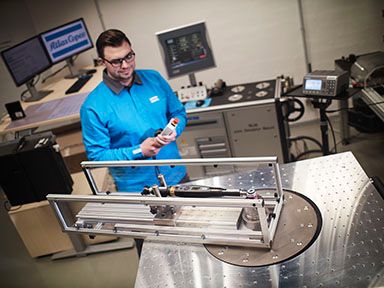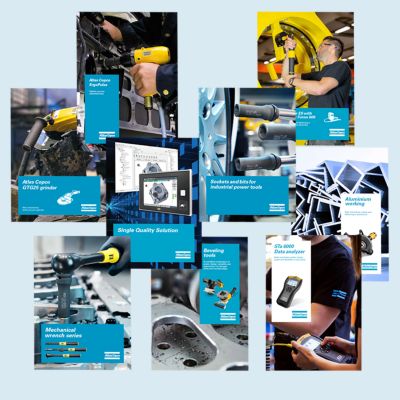In today's fast-paced industrial landscape, safety and efficiency go hand in hand. As technology evolves, so must the practices and standards that keep workers safe and productive. Ensuring that tools are not only effective but also safe for long-term use is vital for both operators and manufacturers alike. One of the key aspects of tool safety that has come under increased scrutiny is shock vibration exposure—a hidden challenge that can have significant impacts on operator health and performance.
Shaping vibration standards
Addressing this challenge requires more than technological innovation; it demands a deeper understanding of the real-world problems operators face every day. Managing the effects of vibrations in dynamic manufacturing environments is a complex but critical task. Recognizing this, Atlas Copco, alongside other industry leaders, has partnered with the International Organization for Standardization (ISO) and the European Committee for Standardization (CEN).
At the heart of this initiative are ISO 5349-3 and ISO 28927 (Parts 1 to 13), standards designed to address the requirements of the EU Machinery Regulation. Scheduled to be applicable from January 2027, these standards focus on filling a critical gap in existing guidelines by accounting for the shock vibrations experienced when using percussive tools.

Reducing risks from percussive tools
According to certain scientific studies vibrations from percussive tools are potentially more dangerous than those from rotary tools. However, current standards don’t fully account for the sudden, high-intensity amplitudes of these tools, leaving operators vulnerable to health risks even at lower vibration levels or shorter trigger times. The introduction of the Vibration Peak Magnitude (VPM) value aims to bridge this gap, by measuring vibration peak magnitude or the mean value of the peak amplitude of the vibration, offering a more precise way to assess the impact of these intense vibrations and ensure that operators are better protected.
This new value isn’t just another tick in a compliance box—it hopes to offer a relative scale designed to give operators and employers a clearer way to compare tools and make well-informed decisions. With this standard in place, risk assessments will become more accurate, helping shape safer working environments. At Atlas Copco, we see this update as an opportunity to advance our ergonomic practices and to intensify our efforts in developing vibration-dampening techniques for percussive tools.
Comparing the old and new standard
Let’s explore how the two metrics can affect different handheld power tools and their vibration values:
Machine Type |
Hand-arm vibration exposure value (m/s2) |
Vibration peak magnitude value (m/s2) |
Pneumatic Grinder |
3,5 |
90 |
Impulse Nutrunner |
3,3 |
220 |
Vibration-Damped Chipping Hammer |
5,0 |
260 |
Impact Nutrunner |
5,0 |
650 |
Conventional Chipping Hammer |
6,1 |
1700 |
The table illustrates how different machine types are assessed under the two distinct metrics: the hand-arm vibration exposure value (HAVs), which reflects traditional vibration measurements, and the VPM value, the newer metric that accounts for the cumulative effect of repeated impacts from shocks.
In this table we can see that the VPM value places greater emphasis on the repeated shocks experienced with percussive tools. For example, while the impulse nutrunner and the pneumatic grinder expose operators to similar levels of vibrations under the HAVs value (3.3 m/s² vs. 3.5 m/s²), the VPM value reveals a different reality, with the impulse nutrunner subjecting operators significantly higher vibrations after taking into consideration the repeated shocks (220 m/s² vs. 90 m/s²).
A similar discrepancy is seen with the vibration-damped chipping hammer and the impact nutrunner, which share the same HAVs value (5.0 m/s²) but differ sharply in VPM value (260 m/s² vs. 650 m/s²). Conversely, the impulse nutrunner and the vibration-damped chipping hammer have VPM values in a similar range (220 m/s² vs 260 m/s²) despite differing HAVs values (3.3 m/s² vs 5.0 m/s²).
These differences underscore the importance of considering both metrics when evaluating tools, ensuring a more accurate assessment of their impact on operator safety and performance.
FAQs: Understanding the New Vibration Declaration Value
When will the new value be introduced?
The new value is set to be implemented in January 2027, and it is mandatory for the CE-Marking of handheld power tools.
Will this be mandated globally?
This is currently an EU legislation, but it aims to influence global industry standards.
Is the 2.5m/s² A(8) value still relevant?
Yes the 2.5m/s² A (8), action value, remains relevant. The new vibration declaration value will serve as a metric for comparing tools.
Which tools will be the most affected by the new standard?
All handheld power tools will be assigned the new vibration declaration value for consistent evaluation.
Does the new value change recommended tool operating times?
The new value does not dictate safe operating times; its intended use is for comparing tools.
How can operators reduce exposure to harmful vibrations?
Refer to our pocket guide on vibrations for guidance on assessing and managing vibration exposure.
Atlas Copco's focus on ergonomics
Our commitment at Atlas Copco goes beyond simply meeting new standards, We’re dedicated to continuously pushing the boundaries of what’s possible in tool ergonomics. We’re focused on researching and refining our products to ensure that our customers can offer their teams safer and more comfortable working conditions. Together, we’re not just adapting to change—we’re driving it, building a future that’s more innovative and safer!




